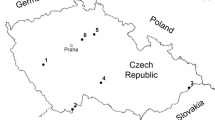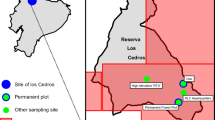Abstract
Here we present the first checklist of the UNESCO World Natural Heritage Kellerwald-Edersee National Park in the federal state of Hesse in Germany. After 10 years of investigation, 1107 species have been recorded. Thus far, efforts have led to the detection of 44 species of interest according to the criteria of the International Union for the Conservation of Nature and Natural Resources (IUCN), 10 species with nature value based on a European scale, and 16 nature-value species on a German scale. Sixty-four threatened species are listed on the German red list of fungi, and 147 species are listed on the regional red list of the federal state of Hesse. As part of the UNESCO World Natural Heritage Ancient Beech Forests of Germany and Primeval Beech Forests of the Carpathians, the Kellerwald-Edersee National Park represents the typical European natural beech forest on poor soil with old tree stands and relict primeval forest fragments. The presence of nature-value species in the beech (Fagus sylvatica)-dominant Kellerwald-Edersee and Hainich national parks shows the development of their forest ecosystems to near naturalness comparable to the primeval forests of the Poloniny National Park in Slovakia.



Similar content being viewed by others
References
Adamčik S, Kučera V, Lizoň P, Ripka J, Ripkow S (2003) State of diversity research on macrofungi in Slovakia. Czech Mycol 55:201–213
Adamčik S, Christensen M, Heilmann-Claussen J, Walleyn R (2007) Fungal diversity in the Poloniny National Park with emphasis on indicator species of conservation value of beech forests in Europe. Czech Mycol 59:67–81
Antonín V, Noorderloos ME (2010) A monograph of marasmioid and collybioid fungi in Europe. IHW-Verlag, Eching
Baral HO (2015) Keys from www.invivoveritas.de. Accessed on various dates in 2014 and 2015
Becker W, Frede A, Lehmann A (1996) Pflanzenwelt zwischen Eder und Diemel: flora des Landkreises Waldeck-Frankenberg; mit Verbreitungsatlas, HGON, Kreisgeschäftsstelle
Benkert D, Dörfelt H, Hardtke HJ, Hirsch G, Kreisel H, Krieglsteiner GJ, Lüteritz M, Runge A, Schmid H, Schmitt JA, Winterhoff W, Wöldecke K, Zehfuss HD (1996) Rote Liste der Großpilze Deutschlands. In: Ludwig G, Schnittler M (eds) Rote Liste der Pflanzen Deutschlands. Schriftenreihe für Vegetationskunde 28. Bundesamt für Naturschutz, Bonn-Bad Godesberg, pp 377–426
Blaschke M, Helfer W, Ostrow H, Hahn C, Loy H, Bussler H, Krieglsteiner L (2009) Naturnähezeiger – Holz bewohnende Pilze als Indikatoren für Strukturqualität. Nat Landschaft 84:560–566
Bockshammer U (1958) Territorialgeschichte der Grafschaft Waldeck. Schriften des Hessischen Amts für Geschichtliche Landeskunde. N. G. Elwert Verlag, Marburg
Chao A, Chazdon RL, Colwell RK, Shen T-J (2005) A new statistical approach for assessing compositional similarity based on incidence and abundance data. Ecol Lett 8:148–159
Christan J (2008) Die Gattung Ramaria in Deutschland. IHW-Verlag
Christensen M, Heilmann-Claussen J, Walleyn R, Adamčik S (2004) Wood-inhabiting fungi as indicators of nature value in European beech forests. Monitoring and Indicators of Forest Biodiversity in Europe - From Ideas to Operationality. EFI Proceedings No. 51
Christensen M, Hahn K, Mountford EP, Dor P, Standovar T, Rozenbergar D, Diaci J, Wijdeven S, Meyer P, Winter S, Vrska T (2005) Dead wood in European beech (Fagus sylvatica) forest reserves. Forest Ecol Manag 210:267–282
Colwell RK, Chao A, Gotelli NJ, Lin S-Y, Mao CX, Chadzon RL, Longina JT (2012) Models and estimators linking individual-based and sample-based rarefaction, extrapolation, and comparison of assemblages. J Plant Ecol 5:3–21
Cosiglio G, Setti L (2008) Il genere Crepidotus in Europa. A.M.B. Fondazione Centro Studi Micologici, Trento
Ellenberg H (2009) Vegetation ecology of Central Europe. Cambridge University Press, Cambridge
Frede A (2009) Naturwälder in der Nationalpark-Region Kellerwald-Edersee – Ein Beitrag zur Urwaldfrage in Deutschland. In: 2. Hessisches Ministerium für Umwelt, Energie, Landwirtschaft und Verbraucherschutz (ed) Hessisches Naturwaldforum Buche., Wiesbaden, pp 70–78
Frede A (2012) Forschung und Monitoring im Nationalpark Kellerwald-Edersee - Konzeption und Koordination in Hessen Forst 2012. In: Hessisches Ministerium für Umwelt, Energie, Landwirtschaft und Verbraucherschutz (ed) 3. Hessisches Naturwaldforum Buche., Wiesbaden, pp 6-10
Frede A, Lehmann W (2013) Farn- und Blütenpflanzen im Nationalpark Kellerwald-Edersee. AFZ Der Wald 2013:15–17
Hahn K, Christensen M (2004) Dead wood in European forest reserves – a reference for forest management. In: Marchetti M (ed) Monitoring and indicators of forest biodiversity in Europe – from ideas to operationality. European Forestry Institute Proceedings No. 51, Saarijärvi, pp 181–191
Hansen L, Knudsen K (1992) Nordic Macromycetes Vol.2 – Polyporales, Boletales, Agaricales, Russulales. University Printing House, Helsinki
Hansen L, Knudsen K (1997) Nordic Macromycetes Vol.3 – heterobasidioid, aphyllophoroid and gastromycetoid Basidiomycetes. University Printing House, Helsinki
Hansen L, Knudsen K (2000) Nordic Macromycetes Vol.1 – Ascomycetes. University Printing House, Helsinki
Heilmann-Claussen J, Verbeken A, Vesterhold J (1998) The genus Lactarius, Fungi of northern Europe Vol. 2. Svampetryk, Tilst
Heilmann-Claussen J, Aude E, van Dort K, Cristensen M, Piltaver A, Veerkamp M, Walleyn R, Siller I, Standovar T, Odor P (2014) Communities of wood-inhabiting bryophytes and fungi on dead beech logs in Europe - reflecting substrate quality or shaped by climate and forest conditions? J Biogeogr 41:2269–2282
Hessisches Ministerium für Umwelt, Landwirtschaft und Forsten (1995) Hessische Biotopkartierung (HB) - Kartieranleitung. 3. Fassung. Hessisches Ministerium für Landesentwicklung, Wohnen, Landwirtschaft. Forsten und Naturschutz, Wiesbaden, 43 pp
Holec J (2001) The genus Pholiota in central and western Europe. Libri Botanici Vol. 20. IHW-Verlag, Eching
Holec J (2008) Interesting macrofungi from the Eastern Carpathians, Ukraine and their value as bioindicators of primeval and near-natural forests. Mycol Balc 5:55–67
Holec J (2013) Fungi of the Carpathians-contributions of Czech mycologists with emphasis on newly described taxa. Acta Biol Crac Ser Bot 55(suppl 1):45–45
Holec J, Kříž M, Pouzar Z, Šandová M (2015) Boubínský prales virgin forest, a Central European refugium of boreal-montane and old-growth forest fungi. Czech Mycol 67:157–226
IUCN (2012) IUCN Red List categories and criteria. Version 3.1. Second edition. Gland, Seitzerland and Cambridge
Jaklitsch WM (2009) European species of Hypocrea Part I: the green spored species. Stud Mycol 63:1–91
Jaklitsch WM (2011) European species of Hypocrea Part II: species with hyaline ascospores. Fungal Div 48:1–250
Knudsen H, Vesterhold J (2012) Funga Nordica – agaricoid, boletoid, clavarioid, cyphelloid and gastroid genera. Nordsvamp, Copenhagen
Krieglsteiner G (2000) Die Großpilze Baden-Württembergs, vol 1. Ulmer, Stuttgart
Kuthan J, Adamčik S, Terray J, Antonín V (1999) Huby národného parku Poloniny [Fungi of the national park Poloniny]. Liptovský Mikuláš, Snina
Langer E (2000) Rote Liste der Großpilze Hessens. Hessisches Ministerium für Umwelt, Landwirtschaft und Forsten, Wiesbaden
Langer E, Bernauer T (2009) Fundbericht von der Tagung der DGfM an der Universität Kassel vom 2.10. - 9.10.2008. DGfM-Mitt 19:15–24
Langer E, Langer G (2013) Pilze im Nationalpark Kellerwald-Edersee. AFZ Der Wald 2013:21–23
Langer E, Langer G, Striegel M, Riebesehl J, Ordynets A (2014) Fungal diversity of the Kellerwald-Edersee National Park - indicator species of nature value and conservation. Nova Hedwig 99:129–144
Lee I, Langer E (2012) New records of Hyphodontia species from Taiwan. Nova Hedwig 94:239–244
Lübcke W, Frede A (2007) Naturschutzgebiete in Hessen. Landkreis Waldeck-Frankenberg mit Nationalpark Kellerwald-Edersee, vol 4. Cognitio, Niedenstein
Mayr R (1991) Gutachten über die Großpilze des Waldschutzgebietes Kellerwald-Edersee. Regierungspräsidium, Kassel
Meyer P, Steffens R (2009) Permanente Stichprobeninventur (PSI) der Waldstruktur im Nationalpark Kellerwald-Edersee. Nordwestdeutsche Forstliche Versuchsanstalt, Göttingen
Mueller GM, Schmit JP, Huhndorf SM, Ryvarden L, O’Dell TE, Lodge DJ, Leacock PR, Mata MM, Umana L, Wu Q-X, Czederpilz D (2004) Recommended protocols for sampling macrofungi. In: Mueller GM, Bills G, Foster MS (eds) Biodiversity of Fungi: Inventory and Monitoring Methods. Elsevier Academic Press, San Diego, pp 168–172
Munk A (1957) Danish Pyrenomycetes: A Preliminary Flora, Dansk Botanisk, Arkiv 17, no. 1. Munksgaard Polysteknisk Trykkeri, Copenhagen
Nationalpark Eifel (2004) Nationalparkplan, Band 1. Nationalparkforstamt Eifel, Schleiden-Gemünd
Nationalpark Hainich (2010) Artenbericht 2010. Tiere, Pflanzen und Pilze im Nationalpark Hainich. Nationalpark Hainich, Bad Langensalza
Nationalpark Kellerwald-Edersee (2008) Nationalparkplan für den Nationalpark Kellerwald-Edersee. Nationalparkamt Kellerwald-Edersee. Hessisches Ministerium für Umwelt, Energie. Landwirtschaft und Verbraucherschutz, Wiesbaden
Ódor P, Heilmann-Claussen J, Christensen M, Aude E, Van Dort KW, Piltaver A, Siller I, Veerkamp MT, Walleyn R, Standovár T, Van Hees AFM, Kosec J, Matočec N, Kraigher H, Grebenc T (2006) Diversity of dead wood inhabiting fungal and bryophyte assemblages in semi-natural beech forests in Europe. Biol Conserv 131:58–71
Oertel B (2003) Bibliographische Recherchen in der Mykologie. Ein Leitfaden für Leser im deutschsprachigen Raum und darüber hinaus. Z Mykol 69:3–42
Rexer K-H (1994) Die Gattung Mycena s.l. – Studien zu ihrer Anatomie, Morphologie und Systematik. Dissertation, University of Tübingen
Schmidt M, Meyer P (2013) 4. Hessisches Naturwaldforum Buche. AFZ Der Wald 2013:4–5
Stangl J (1989) Die Gattung Inocybe in Bayern. Mit Bestimmungsschlüssel der in Mitteleuropa vorkommenden Arten. Hoppea 46:1–388
Thiers B (2014) Index Herbariorum: A global directory of public herbaria and associated staff. New York Botanical Garden’s Virtual Herbarium. http://sweetgum.nybg.org/ih/. Accessed 15 November 2014
Tomšovský M (2001) Remarks on the distribution of Hymenochaete carpatica in Central and Eastern. Europe 53:141–148
UNESCO (2013) Primeval Beech Forests of the Carpathians and the Ancient Beech Forests of Germany (Slovakia / Germany / Ukraine) (N 1133bis). In: World heritage WHC, 13/37.COM/7B.Add, p.60
Waesch G, Preußing M (2013) Bedeutung der Baumartenvielfalt für Moosvorkommen. AFZ Der Wald 2013:18–20
Acknowledgments
We would like to thank Meike Piepenbring, Dominik Begerow and Marco Thines for valuable help with the manuscript and for their expert opinion. Achim Frede is acknowledged for his advice, suggestions and support of the inventory of macromycetes. We gratefully acknowledge the help of the staff and rangers of the Kellerwald-Edersee National Park, who supported us with free accommodations and collection permits. We are also grateful for the financial support from the administration of the Kellerwald-Edersee National Park during the mycological inventory. The “Landes-Offensive zur Entwicklung Wissenschaftlich-ökonomischer Exzellenz” of Hesse’s Ministry of Higher Education, Research, and the Arts is gratefully acknowledged for funding in the framework of the IPF excellence cluster for Integrative Fungal Research.
Author information
Authors and Affiliations
Corresponding authors
Additional information
Section Editor: Franz Oberwinkler
Electronic supplementary material
Below is the link to the electronic supplementary material.
ESM 1
(DOCX 157 kb)
Rights and permissions
About this article
Cite this article
Langer, E., Langer, G., Popa, F. et al. Naturalness of selected European beech forests reflected by fungal inventories: a first checklist of fungi of the UNESCO World Natural Heritage Kellerwald-Edersee National Park in Germany. Mycol Progress 14, 102 (2015). https://doi.org/10.1007/s11557-015-1127-y
Received:
Revised:
Accepted:
Published:
DOI: https://doi.org/10.1007/s11557-015-1127-y




